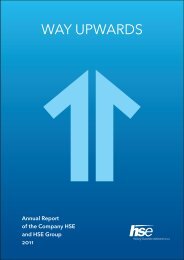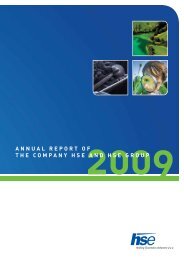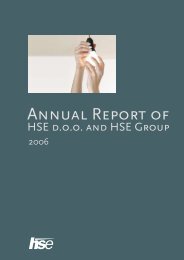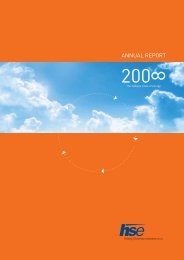Annual report - HSE
Annual report - HSE
Annual report - HSE
You also want an ePaper? Increase the reach of your titles
YUMPU automatically turns print PDFs into web optimized ePapers that Google loves.
In case all actions were performed with the carefulness of a good manager, with intention<br />
to repay certain unsettled receivable and in case that due to the amount of receivable, it<br />
would not be economic for the Group to enter the collection procedure through court,<br />
receivables are finally written down in full based on the management’s decision.<br />
The Group assesses evidence on loan impairment for each significant loan.<br />
Loss due to impairment related to financial asset carried at amortised cost is calculated as<br />
difference between the carrying amount of an asset and expected cash flows discounted<br />
at historical interest rate. Loss is recognised in profit or loss.<br />
5.5.7.8.2 Non-financial assets<br />
On each <strong>report</strong>ing date, the Group companies verify the carrying amount of significant nonfinancial<br />
assets with the purpose to establish whether there are any signs of impairment. If<br />
such signs exist, the recoverable amount of the asset is estimated.<br />
The recoverable amount of an asset or cash-generating unit is the higher of the two: value<br />
in use or fair value less costs of sale. When determining the value of an asset in use, the<br />
expected future cash flows are discounted to their current value by using the discount rate<br />
before tax that reflects regular market assessments of the time value of money and risks<br />
that typically occur in relation to the asset. For the purpose of impairment test, the assets<br />
that cannot be individually tested are classified in the smallest possible group of assets<br />
that generate cash flows from further use and are mostly independent from receipts of<br />
other assets and groups of assets (cash-generating unit).<br />
The impairment of an asset or the cash-generating unit is recognised when its carrying<br />
amount exceeds its recoverable amount. Impairment is disclosed in the income statement.<br />
At the end of the <strong>report</strong>ing period, the companies evaluate losses due to impairment in<br />
previous periods and determine whether the loss has decreased or even disappeared.<br />
Loss due to impairment is reversed in case there has been a change in assessments, on<br />
the basis of which a company defines the recoverable amount of an asset. The impairment<br />
loss is reversed to the amount up to which the asset’s increased carrying amount does not<br />
exceed the carrying amount that would have been determined net of depreciation had no<br />
impairment loss been recognised for the asset in prior periods.<br />
5.5.7.9 Equity<br />
Nominal capital and capital surplus represent cash contributions and in-kind contributions<br />
made by the owner of the controlling company.<br />
As at 31 December 2002, the general equity revaluation adjustments included the<br />
revaluation of share capital before 2002 in accordance with then applicable Slovene<br />
Accounting Standards. The adjustment due to the transfer to new Slovene Accounting<br />
Standards has been transferred to capital surplus. The amount can only be used for<br />
increase in share capital.<br />
Other reserves are amounts that are intentionally retained from the controlling company’s<br />
revenue of previous periods. They are created on the basis of the decision by relevant<br />
management and supervisory body.<br />
Fair value reserve represents amounts arising from revaluation of derivatives and availablefor-sale<br />
financial-assets of the Group.<br />
The retained earnings include profits or loss of the Group companies in the previous years<br />
and in the current year.<br />
The consolidated equity adjustment includes exchange rate differences from translations<br />
of items in financial statements of the Group companies operating abroad.<br />
Minority interest represents the share of minority owners in the total equity of subsidiaries.<br />
<strong>Annual</strong> Report <strong>HSE</strong> 2012<br />
5 Financial Report of <strong>HSE</strong> Group<br />
179
















